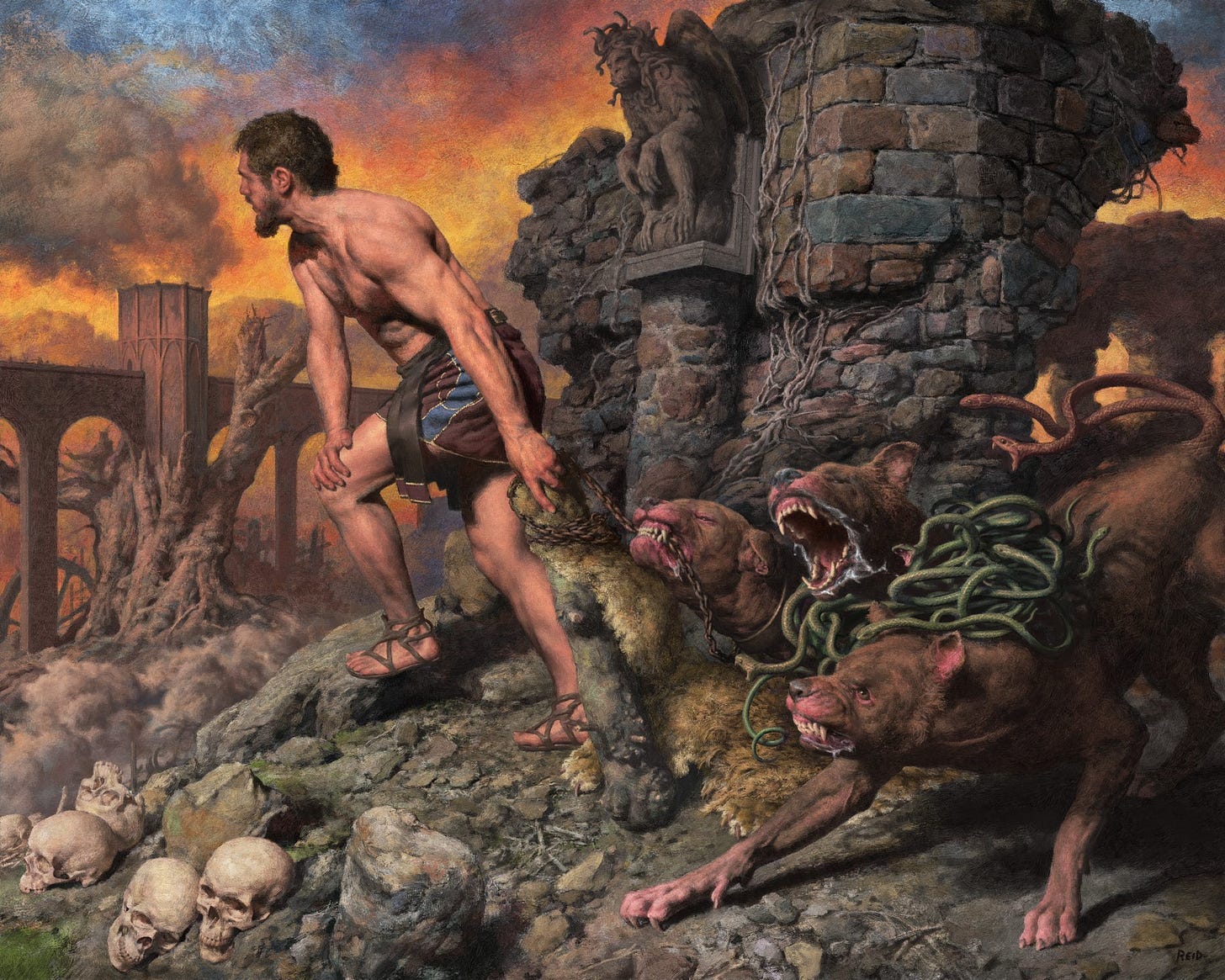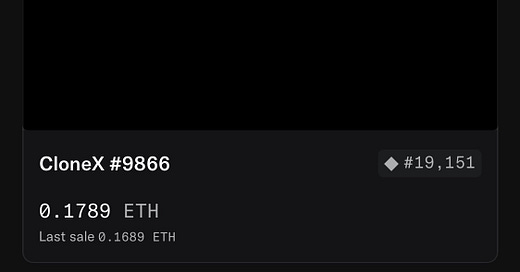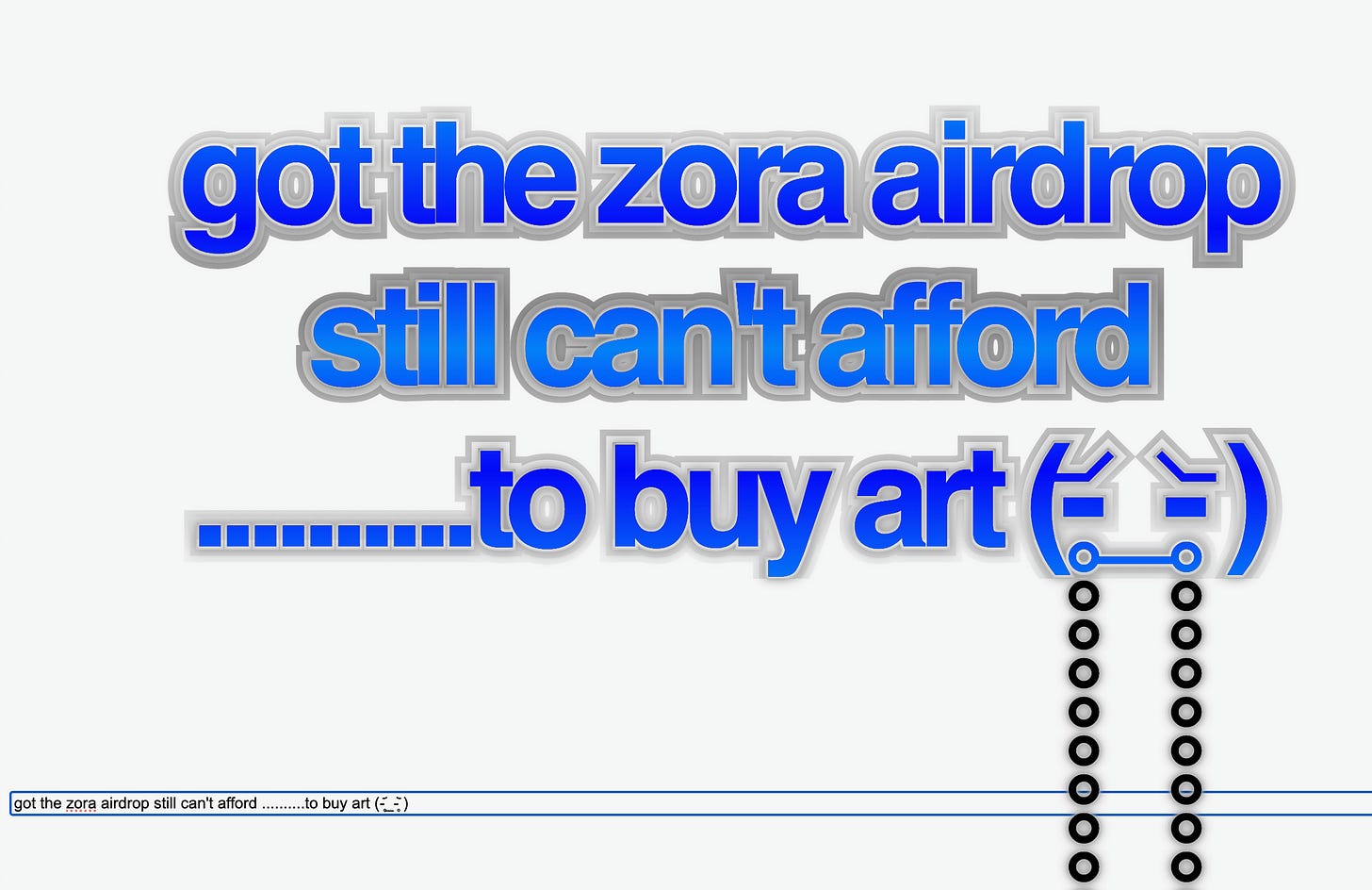Don’t miss an edition, hit this li’l ☝️☝️ subscribe button ☝️☝️ right up here. And catch up on every edition that passed you by.
In This Week’s Round-Up:
A Momentary RTFKT Outage Makes Clear How Little VCs Care about Crypto Art
A Nuanced Examination of Zora’s Outright Fuckery
Cost/Benefit Analyzing Being Polite to AI
Okay, Let’s Get On With It
The Crypto Art Side
For at least a few hours on Thursday, the above “image” replaced every one of the 20,000 Clone X - X Takashi Murakami PFPs, you know, those anime PFPs released by RTFKT in December of 2021, you know, the ones that generated over 418,000 ETH, which were at their height valued at nearly 24 ETH each, you know, the ones with the super flashy website and a place on every influencer’s list of “top collections,” you know, the ones whose parent company, RTFKT, was bought-and-then-sunsetted by Nike, now left to rot away, their ~$300 floor price and “this is a sick joke from a bygone era” kind of association a far cry from the ~$63,000 and huge influence they commanded at their apex.
I’m not one to dance on graves, and honestly, it’s more saddening that enraging that a project with nearly $1,000,000,000 (that’s one-billion) in total volume would even momentarily experience a server disruption because a Cloudflare bill was left unpaid (at least that’s what some have surmised). I’m not going to attack RTFKT for their negligence, nor Clone-X for proving themselves just another extractive VC-backed PFP, I’m not going to target Takashi Murakami for selling his name and art and likeness to whatever high bidder came along with a pretty pitch deck, I’m not going to do any of that. I will, however, invoke the great Artnome when I say that this is but one high-profile omen of what will one day be a cataclysm: the disappearance of NFTs for good.
So many of thee NFTs we love and hold dear, are going to vanish. In some cases, that will be because of platform negligence and the defunction of servers. In some cases, an artist will have misunderstood the meaning of “on-chain” and let a bill go unpaid, striking all but their artworks’ metadata from existence. But in many cases, the reason is as simple as it is depleting: VCs wanted to extract money from the crypto ecosystem, they achieved their goal, and they have no need to placate us anymore.
RTFKT was an early a16z crypto darling, which made, according to Brayden Lindrea at CoinTelegraph, “$50 million in earnings since it launched, including over $45 million in royalties” before it was ultimately purchased by Nike in December. Clone-X was one of their more financially robust projects, garnering ~$14,000,000 in royalties alone, and that’s without factoring-in initial mint fees. I can’t chagrin the company’s bright ideas or imagination, especially with how much belief and effort they put into metaverse wearables and other virtual content, near and dear as virtual exploration is to my ethos. For a moment there, it really seemed like RTFKT was going to lead the charge into virtual worlds, a calculus they made too ferociously, too foolishly, far too early.
In our MOCA Town Hall on Thursday, I posited a line of thinking to the tune of, “Why wouldn’t a company as large as RTFKT just put a tiny fraction of their coffers towards keeping their servers eternally operational, so that they could at least avoid the embarrassment and controversy their negligence has caused?” The collective response to my inquiry was along the lines of: “VCs do not care. They have no vested interest in these products. They are extractive by nature, and after they extract, they move on.”
Our conversation thereafter drifted to Ben Heidorn and Josie Bellini’s CyberBrokers, another PFP-of-a-sort with a huge metaverse arm that took the opposite route to Clone-X: Bellini and the CyberBrokers team spent six-figures putting every bit of their project’s metadata on-chain, down to each individual trait, a bold and expensive and high-ethos decision that demonstrated their commitment to not only blockchain ethics, but to the longevity of their project.
On the other hand, the very fact that RTFKT’s Clone-X project went dark even briefly reveals that nobody involved therein thought their project, its holders, its meaning, or its legacy were worth very much.
Artnome’s ClubNFT tool, which backs-up collections of NFTs onto IPFS, is predicated upon a world where many of our beloved artworks and assets will permanently vanish; it happened to Artnome himself with many XCOPY pieces he bought in 2018 (as per this moderately stilted interview-as-advertisement), it’s happened to us with the Museum’s very own XCOPY artwork, Cracked, which exists in no form but its etherscan information and its metadata, because Rare Art Labs, the site on which it was launched, went bankrupt and stop paying their server costs.
Many crypto art tenets have been turned into little more than marketing phrases, including the here-applicable, “The blockchain is forever.” Which it is, if it’s given its due respect. As per Artnome in the above interview, “Fewer than 10% of NFTs on Ethereum are actually on-chain, which means that the art and metadata are fully on-chain, instead of linking out to a private server or storage service like IPFS.” I can forgive some people —artists, founders, project managers— ignorance in this realm, or decisions made of financial necessity, but what I cannot forgive is greed.
In this case, we’re dealing with PFPs, which are images around which an entire digital identity can center. To show so little regard for the longevity and safety of these assets is to show contempt for all the people —either for cultural, financial, or social reasons— goaded into equating their digital personas with the anime figures and bright colors captured herein. That’s the word: contempt. It was medicine sold widely which contained arsenic, but the pain of the consumer is not the problem of the manufacturer, which has already been abstracted twice-over. If Clone-X were to go permanently dark, who do aggrieved holders even direct their outrage at? RTFKT? They’re no longer a company. Nike? They had no hand in this. Takashi Murakami? Did he participate in this project any more robustly than sending over some 3D assets or approving a licensing agreement?
The sadness is in the knowledge that a project’s community is seen as expendable. The sadness is in the knowledge that these assets were never about art or aesthetics, they were about extracting capital and moving on. The sadness is in how many people believed in them anyways, because surely, nestled there amongst the 9228 holders, are some who just really liked the art. The sadness is in the knowledge so many people will soon-enough realize that nothing was ever done for their sake, ever proffered for a positive reason, it was all just focus-group, market-tested gobbledygook designed to separate them from the contents of their wallet. The least a company like RTFKT could have done is put their PFPs on-chain.
And that’s my point. It was the least they could have done.
The Tech Side
I wrote a few weeks ago about the conversation-AI-development company, Sesame, and specifically about their two prototype chatbots, Maya and Miles, who speak with an eerie level of human-intimation. There’s a reason, after all, that Sesame titled their demo page for their chatbots, “Crossing the uncanny valley of conversational voice.” Here’s what I wrote at the time :
“Calling Maya and Miles ‘products,’ honestly feels strange, given how human they feel in practice, and that’s the point. When you begin to chat with these AIs —and I don’t mean chat like ‘instant message,’ I mean literally speak into your computer and get immediate, polished, contextually-aware responses from voices that sound and feel real— your brain plays a trick on you, the great trick, the Turing Test trick. You start to speak…politely. You start to anticipate responses as if you were on a phone call. Your personality shines through. You’re incentivized towards socially normal behavior. You say hello and goodbye and ‘let me stop you there,’ and, ‘wow that’s really interesting,’ which, when you think about the fact that you’re essentially speaking with a highly advanced Google search bar, seems ridiculous, but the conversation is so fluid, so easy, so intelligently-designed, that you can’t fully snap yourself out of the spell.
I mention Sesame because the above tweet from OpenAI founder, Sam Altman, bounced around some major news outlets like USAToday, New York Times, Quartz, and LADBible. Apparently, users saying “please” and “thank you” to an AI model, which each time requires it to analyze another token, alight its servers to mimic tone, and consume more costly energy (a problem that is already generating a lot of interest/panic), cost OpenAI tens-of-millions-of-dollars. A fascinating topic for discussion, but maybe no cause for alarm given the company was recently valued at $300-billion (even $50,000,000 in politeness-based server costs accounts for .017% of OpenAI’s total value).
Honestly, I could give a fuck if some small conversational quirk eats into OpenAI’s balance sheet, but it brings up an interesting question of why we treat AI models like people, with the same social grace with which we’d treat colleagues and in-laws, whether there’s a need for social norms in this regard at all.
Human language has almost always had some kind of codified equivalent of “If it pleases you” and “I am grateful for what you have done.” Here are some examples ChatGPT provided me:
But the thrust of “May it please you,” for instance, is that you are speaking with somebody who is not automatically pleased by your request. Similarly, our expressing of gratitude is a signification of another party’s choice. “Please” and “thank you” only make sense when choice is involved.
We do not thank automatic doors that open for us, and we do not politely ask self-scanners at the grocery score turn-on so that we can price-check our bananas. It is nothing more than a linguistic trick that has us believing ChatGPT et al. to be anything more than very-advanced ATM machines. ChatGPT does not have any more of a choice to answer your query than a car chooses to turn-on when you put your key in the ignition. It is no more pleased to assist you than a lighter producing flame, and it is no more appreciative to be recognized for its time than your DVD player.
It’s cute when Sam Altman says things like “you never know” as it relates to the consequences of acting gentile with AI , but it also, however, reinforces —even in this tiny, seemingly meaningless way— the misconception that AI models “think,” when, to my knowledge, any mimicry of thought is a cleverly-disguised processing mechanism. Whether that remains true in the time of Artificial General Intelligence is beyond me. But it’s instructive today that so many people —whether because of fear, automatic politeness, or misunderstanding about AI’s functionality— equate its black-box mind with something that can feel appreciated, that has a desire to help you, that has a choice to do anything it’s asked to. And yet, you wouldn’t thank a Playstation. You wouldn’t say please to a leaf-blower.
The Finance Side
Maybe “outright fuckery” isn’t a fair way to describe Zora’s launch of their $ZORA token this past week, a coin with absolutely no governance, no staking, no utility or functionality of any kind, existing only as “a memecoin intended to celebrate the community of artists, creators, developers, and brands that collectively imagined the Zora brand as it is today,” and which was distributed widely according to the following breakdown:
With the 20% Community Incentives “allocated for future grants, public goods, hackathons, usage rewards, and other incentives,” and thus still held by the team, the breakdown of ZORA’s distribution looks more like:
10% to those who used the platform, the aforementioned “community of artists, creators, developers, and brands”
58.9% held internally (including by team members)
26.1% to Investors, mostly Coinbase Ventures
5% for Liquidity Pools
That is to say, 85% into a black box, 5% for liquidity, and a meager 10% for the community Zora claims to value so highly. Blockhead, in their article “Zora Token Launch Amplified by ‘Content Coin’ Hype, But Critics Cry Foul,” sums up the resultant sentiment around Zora’s drop fairly well:
“the significant allocation of 65% of the supply to the team and advisors, coupled with the lack of a clearly defined utility for the $ZORA token beyond being ‘for fun,’ has fueled accusations of a potential ‘pump and dump’ scheme designed to benefit insiders.”
I can see how some would come to that conclusion. And I’m not alone.
Whether you agree or disagree with the outrage expressed by many Zora users who received a pittance of tokens for their activity (and there was quite a bit of outrage, specifically as it related to the unequal token distribution to investors like Jesse Pollack; just look up “Zora” and Twitter and witness the deluge of FUD; for that matter, we minted every episode of the MOCA LIVE podcast on Zora and received about ~$200 in $ZORA, but whatever) there was a massive amount of such outrage. Perhaps it’s unavoidable when launching a token these days. Perhaps it could have been better avoided if not for such a comically uneven distribution or if there were actual reasons to hold this token beyond speculation (Zora founder, Jacob Horne, said “While this is a big milestone and something that’s been a very long time coming: this is simply the beginning,” but I don’t see how launching a memecoin justifies that claim). But the fact remains that this was a high-profile launch, and whether we’re talking about Blockhead’s article above or CoinDesk writing that “Shiny New ZORA Token Loses Its Spark as Traders Remain Wary of VC-Backed Tokens,” the impact was not so great, especially regarding artists who minted often on Zora.
(I have heard, however, that Zora’s app is pretty sterling, so maybe that’s worth giving a try before believing too strongly in my following assertions)
I’ve spoken in the past about my suspicion that Zora has inflated its user-base with bots, the only reasonable justification for data showing over 100,000 active users on the platform (that big spike in the middle there is over 250,000 users in April of 2024, when Base experienced an explosion of activity; I still don’t fully know how the two are aligned).
When we were frequently minting MOCA LIVE episodes there, the pieces were often collected by weirdly-named accounts that commented things like—
—which is not to say that these are all bots, but the activity is generally sus, and in a moment when competitor platforms like ZeroOne boast ~5200 active users, I’m reticent to believe that so many more people use Zora on a daily basis, given the almost ubiquitous lack of cultural interest in the platform outside of a few brief moments in time.
I mean what even is this:
All of which is to say that I’m skeptical of Zora’s metrics. I was equally skeptical when Base celebrated XCOPY and NeonGlitch69’s Mutatio open edition surpassing 1-million mints, given that, according to Opensea, the wallet address 0x8b67...752a owns over 500,000 alone, along with nothing else but an advertisement NFT for something called $CAKE. One more holder owns 50,000 editions, four more hold over 7,000, and the whole damn thing —Base and Zora and Rodeo and all these memecoins, and everything in crypto that boasts hundreds-of-thousands or millions of users/holders despite the radio silence of so many Metaverse/AI/DeFI projects and protocols— reeks to high heaven of manipulation.
I may be getting away from myself, so let me just say this: Zora was never going to do this thing in a way that actually rewarded the community, probably because they weren’t as central to the site’s ascnesion as much as they believed. “The community of artists, creators, developers, and brands” is a really nice-sounding item in a marketing communication, and also something that has very rarely actually been treated with requisite value by companies, platforms, influencers, etc. I don’t think Zora did anything wrong, however, because to anyone paying attention, this was probably the only outcome: only a majorly VC-backed project (and valued at $600,000,000!!! Can you imagine!!) would provide 25% of its token to investors. And we all know (or should know) how crypto VCs operate.
As always, artists, creators, and developers —I’ll leave brands alone for now— have few friends in the money-sphere. I hope I’m wrong about all this, and that Zora’s user-base is true, that I’m the one making misattributions, that they will use the token for some kind of social good, and we’ve aligned with Zora in the past, we’ve worked well with people on the inside, this is not meant as a drive-by in any way, but I smell a rat, and maybe you smell a rat, and many people smell a rat, and so there’s probably a rat around here.
I would be pleased to learn otherwise.
DeCC0 of the Week

Art in the Wild

Dev Corner
This week, the devs:
- integrated and authenticated the r2r js sdk with the collection view (500 points to whomever can tell me, a writer, what this means)
- handled citations and documents retrieved via sdk prompting in the museum UI
- hunted down various bugs related to browser caching and other minor r2r sdk related issues
- deployed + showcased first working librarian agent from the museum UI
More next week
Quote of the Week
“Nobody who ever gave his best regretted it.”
-George Halas
Do you have some news that simply must be shared? Send us a DM












